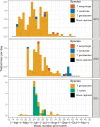Development of an operational trap for collection, killing, and preservation of triatomines (Hemiptera: Reduviidae): the kissing bug kill trap
- PMID: 39024462
- PMCID: PMC12102606
- DOI: 10.1093/jme/tjae087
Development of an operational trap for collection, killing, and preservation of triatomines (Hemiptera: Reduviidae): the kissing bug kill trap
Abstract
Surveillance of triatomines or kissing bugs (Hemiptera: Reduviidae: Triatominae), the insect vectors of Trypanosoma cruzi, a Chagas disease agent, is hindered by the lack of an effective trap. To develop a kissing bug trap, we made iterative improvements over 3 years on a basic design resulting in 7 trap prototypes deployed across field sites in Texas, United States and Northern Mexico, yielding the capture of 325 triatomines of 4 species (Triatoma gerstaeckeri [Stål], T. sanguisuga [LeConte], T. neotomae [Neiva], and T. rubida [Uhler]). We began in 2019 with vertical transparent tarpaulin panel traps illuminated with artificial light powered by AC current, which were successful in autonomous trapping of flying triatomines, but were expensive, labor-intensive, and fragile. In 2020, we switched to white LED lights powered by a solar cell. We tested a scaled-down version of the vertical panel traps, a commercial cross-vane trap, and a multiple-funnel trap. The multiple-funnel traps captured 2.6× more kissing bugs per trap-day than cross-vane traps and approached the performance of the vertical panel traps in number of triatomines captured, number of triatomines per trap-day and triatomines per arthropod bycatch. Multiple-funnel traps required the least labor, were more durable, and had the highest triatomines per day per cost. Propylene glycol in the collection cups effectively preserved captured triatomines allowing for molecular detection of T. cruzi. The trapping experiments established dispersal patterns for the captured species. We conclude that multiple-funnel traps with solar-powered LED lights should be considered for adoption as surveillance and potentially mass-trapping management tools for triatomines.
Keywords: Mexico; Texas; multiple-funnel trap; surveillance; trapping.
© The Author(s) 2024. Published by Oxford University Press on behalf of Entomological Society of America. All rights reserved. For commercial re-use, please contact reprints@oup.com for reprints and translation rights for reprints. All other permissions can be obtained through our RightsLink service via the Permissions link on the article page on our site—for further information please contact journals.permissions@oup.com.
Conflict of interest statement
The researchers declare that the prototype trap developed during this study is associated with a provisional patent application filed on behalf of GLH, MGB, and JHB and assigned to their respective institutions with an assignment to the US government.
Figures




Similar articles
-
Advancing the design of the kissing bug kill trap for surveillance of triatomines.bioRxiv [Preprint]. 2025 May 15:2025.05.09.653139. doi: 10.1101/2025.05.09.653139. bioRxiv. 2025. PMID: 40463053 Free PMC article. Preprint.
-
An Experimental Evaluation of Cross-Vane Panel Traps for the Collection of Sylvatic Triatomines (Hemiptera: Reduviidae).J Med Entomol. 2018 Feb 28;55(2):485-489. doi: 10.1093/jme/tjx224. J Med Entomol. 2018. PMID: 29272499
-
A baited trap for kissing bugs (Hemiptera: Reduviidae: Triatominae).Acta Trop. 2024 Nov;259:107368. doi: 10.1016/j.actatropica.2024.107368. Epub 2024 Aug 22. Acta Trop. 2024. PMID: 39173727
-
Integrated pest management strategies targeting the Florida kissing bug, Triatoma sanguisuga: Preventing this vector of Chagas disease from invading your home.Curr Res Parasitol Vector Borne Dis. 2023 Sep 28;4:100144. doi: 10.1016/j.crpvbd.2023.100144. eCollection 2023. Curr Res Parasitol Vector Borne Dis. 2023. PMID: 37841307 Free PMC article. Review.
-
Evolution, Systematics, and Biogeography of the Triatominae, Vectors of Chagas Disease.Adv Parasitol. 2018;99:265-344. doi: 10.1016/bs.apar.2017.12.002. Adv Parasitol. 2018. PMID: 29530308 Review.
Cited by
-
Triatoma dimidiata, domestic animals and acute Chagas disease: A 10 year follow-up after an eco-bio-social intervention.medRxiv [Preprint]. 2025 Mar 13:2025.03.11.25323671. doi: 10.1101/2025.03.11.25323671. medRxiv. 2025. Update in: Parasit Vectors. 2025 Jul 4;18(1):253. doi: 10.1186/s13071-025-06897-7. PMID: 40162261 Free PMC article. Updated. Preprint.
-
Advancing the design of the kissing bug kill trap for surveillance of triatomines.bioRxiv [Preprint]. 2025 May 15:2025.05.09.653139. doi: 10.1101/2025.05.09.653139. bioRxiv. 2025. PMID: 40463053 Free PMC article. Preprint.
-
Triatoma dimidiata, domestic animals and acute Chagas disease: a 10-year follow-up after an eco-bio-social intervention.Parasit Vectors. 2025 Jul 4;18(1):253. doi: 10.1186/s13071-025-06897-7. Parasit Vectors. 2025. PMID: 40616155 Free PMC article.
References
-
- Abrahan LB, Gorla DE, Catalá SS. 2011. Dispersal of Triatoma infestans and other Triatominae species in the arid Chaco of Argentina: flying, walking or passive carriage? The importance of walking females. Mem. Inst. Oswaldo Cruz. 106(2):232–239. https://doi.org/10.1590/s0074-02762011000200019 - DOI - PubMed
-
- Angulo VM, Esteban L. 2011. New trap for the capture of triatomines in wild and peridomestic habitats. Biomédica. 31(2):264–267. - PubMed
-
- Angulo VM, Esteban L, Urbano P, et al. 2013. Comparison of methods for the capture of triatomines (Hemiptera: Reduviidae) in Attalea butyracea palms in the Eastern Plains of Colombia. Biomédica. 33(4):653–659. https://doi.org/10.7705/biomedica.v33i4.835 - DOI - PubMed
-
- Barbu C, Dumonteil E, Gourbière S. 2011. Evaluation of spatially targeted strategies to control non-domiciliated Triatoma dimidiata vector of Chagas disease. PLoS Negl. Trop. Dis. 5(5):e1045. https://doi.org/10.1371/journal.pntd.0001045 - DOI - PMC - PubMed
-
- Beatty N, Bradley-Behrens N, Love M, et al. 2018. Southern Arizona town: homes colonized by kissing bugs. Is Chagas disease being transmitted? Open Forum Infect. Dis. 5(Suppl 1):S161. https://doi.org/10.1093/ofid/ofy210.435 - DOI
MeSH terms
Grants and funding
LinkOut - more resources
Full Text Sources

